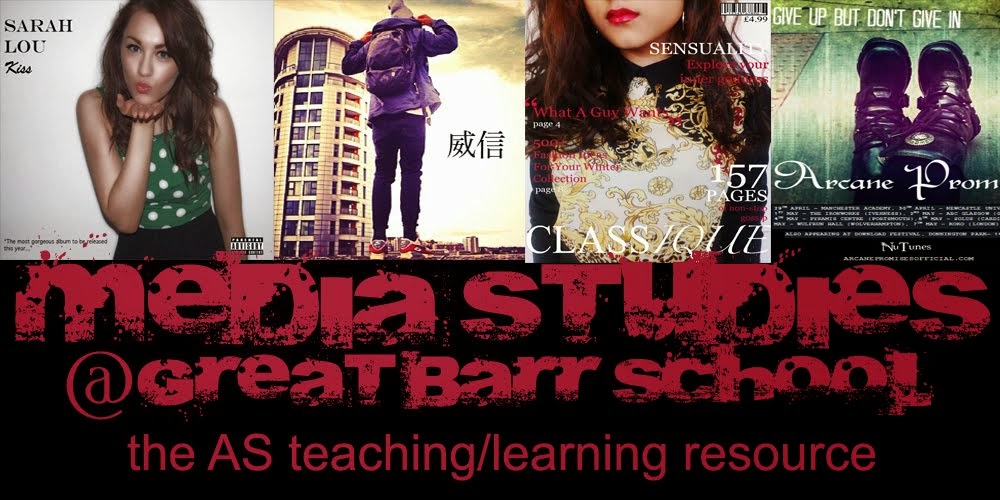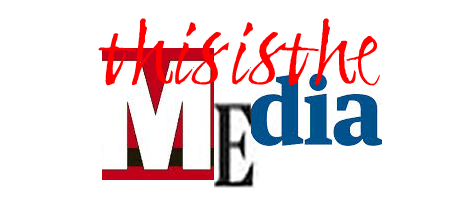I have been absent from work ill so we have not been able to arrange any revision sessions or respond to any email questions this week.
Having said this, the take-up of the previous revision session was very low and I have had only one email request for direct support with a problem. These facts, combined with my involvement in interview panels on Thursday, mean that we have decided that we will not be running any additional sessions prior to the examination.
If you have any problems or matters you wish clarified then either email me or drop into school over the next few days and we'll sort these out for you.
I will be in school from 8:00 on the day of the examination for any last minute issues or the chance to rah-rah you ahead of the paper.
media studies

student work 2012/14
Wednesday 20 May 2015
Friday 8 May 2015
MEDIA REVISION SESSION 1 T8 MONDAY 11TH MAY 1:30
Start 1:30 Ends 3:00
The first session will be in T8 and will focus on some basic approaches to the examination paper. We will explore Section A responses - structure; organisation; key theories - and Section B case study issues
Thursday 7 May 2015
NEWS AGENDAS: PRINT MEDIA AND THE ELECTION
The election day media.
The Sun's use of what has become a pop-culture icon to make a pejorative front page on polling day. The attack on personality rather than politics might be seen as a trope of tabloid coverage - something the lesson on The Trews last week made clear for some of you.
The coverage is a very good example of McCombs [1998] Agenda Framing Theory with the Sun keen to engage in personality attacks rather than a discussion of issues and opts to represent Miliband as incapable by the correlation of the image to his lack of fitness to govern the country. We might begin to consider why a Murdoch owned institution has such an agenda - the parent company inks to gas and oil industry and Miliband's stance on energy capping, perhaps?
http://www.theguardian.com/media/2015/may/06/sun-ed-miliband-labour-mail-telegraph-election
The post- election day media. Explore the portrayal of the news - the range from factual [The Telegraph] through triumphal [The Mail] to the sensational [The Star]. Appropriate to consider the way that the coverage indicates the agenda and ideology of each of these institutions.
http://www.theguardian.com/media/gallery/2015/may/08/election-2015-the-front-pages-in-pictures
The Sun's use of what has become a pop-culture icon to make a pejorative front page on polling day. The attack on personality rather than politics might be seen as a trope of tabloid coverage - something the lesson on The Trews last week made clear for some of you.
The coverage is a very good example of McCombs [1998] Agenda Framing Theory with the Sun keen to engage in personality attacks rather than a discussion of issues and opts to represent Miliband as incapable by the correlation of the image to his lack of fitness to govern the country. We might begin to consider why a Murdoch owned institution has such an agenda - the parent company inks to gas and oil industry and Miliband's stance on energy capping, perhaps?
http://www.theguardian.com/media/2015/may/06/sun-ed-miliband-labour-mail-telegraph-election
The post- election day media. Explore the portrayal of the news - the range from factual [The Telegraph] through triumphal [The Mail] to the sensational [The Star]. Appropriate to consider the way that the coverage indicates the agenda and ideology of each of these institutions.
http://www.theguardian.com/media/gallery/2015/may/08/election-2015-the-front-pages-in-pictures
Tuesday 5 May 2015
REPRESENTATION : WHEN WORLDS COLLIDE
This lesson is all about representation - is what we see what we get?

We begin with a reminder that we live in two worlds : media world and social reality world. These worlds co-exist, we step easily from one to the other and when we do so, we take with us aspects of each. For some, the influence of media world is limited, has little impact on our social reality. For others, the two intertwine so much so that they have problems in sorting one from the other. the convergence and inter lapping of these two realities is the core of the study of modern media.
Let's begin our revision with a clip:
On the surface, this is a pretty straightforward product. A TV advert for a breakfast cereal aimed at both the young consumers of the cereal, but much more so at the parents who make the purchase. The brand / institution are fully aware of the modern media debate surrounding gender stereotyping and the criticisms of some products exploitation of gender [the LEGO adverts/magazine being but one of these].
The institution producing this product [Weetabix] are clearly manipulating the trope of boy/girl in a very obviously playful manner to create a humourous effect. The media language is key in this - the alternating dominance of the pink and blue colour palettes; the narrative elements; - but there are a great many other less obvious tropes here. Notice the dad [sitting in the chair watching football; unaware of children] the mother [busy in the kitchen] to see how this advert sustains the stereotypes that it purports to be ridiculing in a very knowing we're all in on the joke post modern manner.
The product is manipulating many of the common assumptions about gender - feminine and masculine behaviour. It's defence would be that the intent is humour, but the product is also circulating such values and suggesting to some audiences that the issues involved [how we define ourselves] is unimportant, trivial [application of Hall]. It's final message, of course, is all about dominance by power.
The product underlines some of the key media debates: explicit/implicit meanings; media encoding intentions / aberrant decodings; representations of groups; persuasive power of media; modern techniques of encoding [post-modernism as in the Dove and Always campaigns] that suggest a brand understands and shares audience concerns about media debates in order to align themselves with consumers.
For our revision, we need to extend ourselves into developing our understanding of concepts rather than simply knowing the concept. Remember, the AQA mark scheme and AOs mention knowledge and understanding as two separate criteria with understanding as much more worthwhile. We can do this by looking at aberrant decoding and stretch this into the correlation theory of media products.
Sometimes products can run into serious problems of decoding. the Fox series EMPIRE is the story of a family engaged in a war of succession over its business empire of a record label. The main arc is a riff on the classic King Lear [an aging/dying king wanting to secure the family fortunes inadvertently creates violent sibling rivalry that destroys them all] but it has hit criticism [from Black Americans] that its all black cast merely fulfills all of the classic tropes of black America - guns, drugs, rap music, money, cars, prison, crime and prostitution.
Whilst the creators argue that it is a family drama, the location of the narrative in the Rap and Rand B music industry is seen as a trope - why not a firm of accountants, some have asked? Well, clearly, the music industry offers rather more exotic and glamorous story-lines and backdrops than KPW, but what Fox believed might be ground-breaking [an all black cast glossy drama with A list cameos and A list producers - Brian Glazer] has been slated for its narrow range of tropes of Black America that simply sustain rather than challenge the existing ideologies in its target [Black American] audience as well as its wider [white American] audience.
The second season airing in America at a period of violent ethnic based riots and killings in Ferguson and elsewhere, it plays badly in the choice of some of its story-lines and some of the key representations of many of the characters' behaviours and ideologies. The media debate of saturation and contextualization come into play - the intertwining of stories from different platforms creating a meaning as the fictions of Empire merge with the daily news shows. The impact of the show on understanding of the news [and vice-versa] is correlation. Each product informs the other and how audiences 'read' them. Consider an audience that watches Empire and then it is followed by the following news slots.
What possible impact does the viewing of Empire have on how audiences 'read' the news?
We might also explore the issue that the rioters are overwhelmingly black males in hoodies - what about the news anchors?
The same issues covered by a independent news station - might lead us to consider the pluralism debate and citizen journalism.
Are the issues of the riots presented differently here by a community station? How so?
A final issue might be to explore the idea of how series reflect the prevailing zeitgeist in their themes as much as they manipulate and sustain tropes. There has been criticism form some [Fifty Cent] that the series Empire is both a rip off of his own Executive produced TV series Power and also that Empire's main character [Lucious Lyon] is based on 50 Cent himself]
Friday 1 May 2015
SON OF BENEFITS STREET
Well, here we go: the final few weeks; the Final Countdown; Last chance to drink in the last chance saloon; Body shape issue lady already gargling and preparing to sing.
The final few hours of taught time - though we will have one or two mega-revision master classes and the blog will be here 24/7 for you.
I thought we'd finish by taking a look at a product that last year's year 12 found offered a treasure trove of ideas for understanding the inter-weaving of many strands of the course of study : Benefits Street.
the first session will be a re-hashing of some of the ideas looked at last year and a useful prep for those of you who missed the first series in 2014 [so last year, darling].
http://www.theguardian.com/media/2015/apr/30/benefits-street-press-series-two
RETURN OF THE SON OF EXAM MIND READY
We come full circle.
History repeats itself: the first time as tragedy, the second as comedy.
Carlsberg have stepped into the Protein World controversy - the feminist/shapist debate - with a view of their own. The advert, featuring a pastiche [borrowed identity/inter-textuality] of the infamous advert that targets its audience with a 'typical' laddish/blokey reaction. the advert - hurriedly positioned in some tube stations next to the Protein World advert - shows a bottle of Carlsberg in yellow swimwear with the tag 'are you beer body ready'
The advert,in poking fun at the raging debate, suggests its own brand identity as being cheeky and blokey in its outlook and further cements it in the hearts of those men who are its consumers. It is irreverent to the feminist/shapist debate and seems to almost comment on the furor around body image.
At the very least, surely we all get what inter-textuality [borrowed identity/borrowed interest] is now? Please.
http://www.theguardian.com/media/mediamonkeyblog/2015/apr/30/carlsberg-dont-do-beach-ready-bodies-advert
http://www.mirror.co.uk/news/uk-news/protein-world-carlsberg-unveil-cheeky-5611002
History repeats itself: the first time as tragedy, the second as comedy.
Carlsberg have stepped into the Protein World controversy - the feminist/shapist debate - with a view of their own. The advert, featuring a pastiche [borrowed identity/inter-textuality] of the infamous advert that targets its audience with a 'typical' laddish/blokey reaction. the advert - hurriedly positioned in some tube stations next to the Protein World advert - shows a bottle of Carlsberg in yellow swimwear with the tag 'are you beer body ready'
The advert,in poking fun at the raging debate, suggests its own brand identity as being cheeky and blokey in its outlook and further cements it in the hearts of those men who are its consumers. It is irreverent to the feminist/shapist debate and seems to almost comment on the furor around body image.
At the very least, surely we all get what inter-textuality [borrowed identity/borrowed interest] is now? Please.
http://www.theguardian.com/media/mediamonkeyblog/2015/apr/30/carlsberg-dont-do-beach-ready-bodies-advert
http://www.mirror.co.uk/news/uk-news/protein-world-carlsberg-unveil-cheeky-5611002
Subscribe to:
Posts (Atom)

